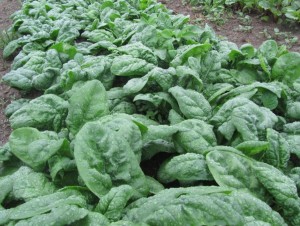Availability, Nutrition, and Recipe Suggestions
In Season: Mid May – June, October – November
Storage: Store fresh spinach in a clean container wrapped with paper towels. Place it in the refrigerator in the crisp drawer to save the greens for up to ten days. Containers will protect the greens from being moved around or crushed like they would in bags. Paper towels absorb the moisture, and keep your spinach fresh.
Preservation: Freeze Technique: Rinse leaves very well. Blanch spinach leaves in boiling water or steam for two minutes (you can save the green water to use for stocks or rice), followed by soaking in ice water for the same amount of time. Remove excess water by draining or a salad spinner. Place in freezer bags in appropriate portions.
Production Notes: We harvest fresh spinach from the fields starting in mid May through late June. Our fall crop varies each season and is typically available early October into November. For our “fall into winter” CSA members we harvest spinach from the fieldhouses through the winter and spring.
Varieties: Our spinach varieties change regularly as the seed folks keep developing new and productive varieties. As of 2019 we currently like Space and Corvair for our spring crop, Seaside for the summer heat, and Carmel for the fall.
Nutrition: Spinach is an extremely nutrient-rich vegetable. It contains high amounts of carotenoids, vitamin C, vitamin K, folic acid, iron and calcium. [www.healthline.com]
Deep Nutrition: Quercetin: This antioxidant may ward off infection and inflammation. Spinach is considered a good dietary sources of quercetin; see also onions for quercetin. [www.healthline.com]
Deep Science: From WH Foods – “Anti-Inflammatory Support- In research studies on spinach, it is not difficult to trace an ongoing interest in the anti-inflammatory benefits of this green leafy vegetable, especially with respect to events inside our digestive tract. We suspect that much of this interest is due to the multi-faceted nature of spinach in terms of anti-inflammatory nutrients. In the phytonutrient category, spinach flavonoids are important in this regard since spinach is known to contain glucuronide and glucopyranonside forms of the flavonoids spinacetin, patuletin, and jaceidin. All of these flavonoids have anti-inflammatory properties and some have the ability to decrease cancer risk.”
Preparation: Depending on recent weather conditions, our Spinach may benefit from a double rinse, washing more then once to remove any surface dirt. Spinach is a very low growing crop and tends to be dirty after heavy rainfall. Remove excess moisterure and eat fresh. Or chop to desired size and add to any dish you want to prepare.
Spinach Recipe Suggestions:
- Easy Garlic Lemon Spinach [bestrecipebox.com]
- Creamy Spinach and Kale Dip [minimalistbaker.com]
- Best Ever Strawberry Spinach Salad [theslowroasteditalian.com]
- Vibrant Coconut Green Curry (green from the spinach) [minimalistbaker.com]
Yum.
authored by: Danny Guillotte and Derek Christianson
February 2018, Updated September 2019
